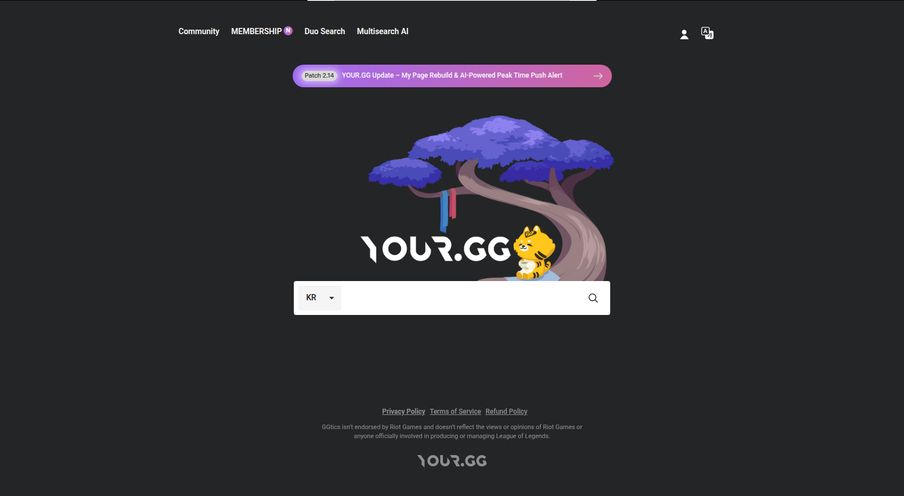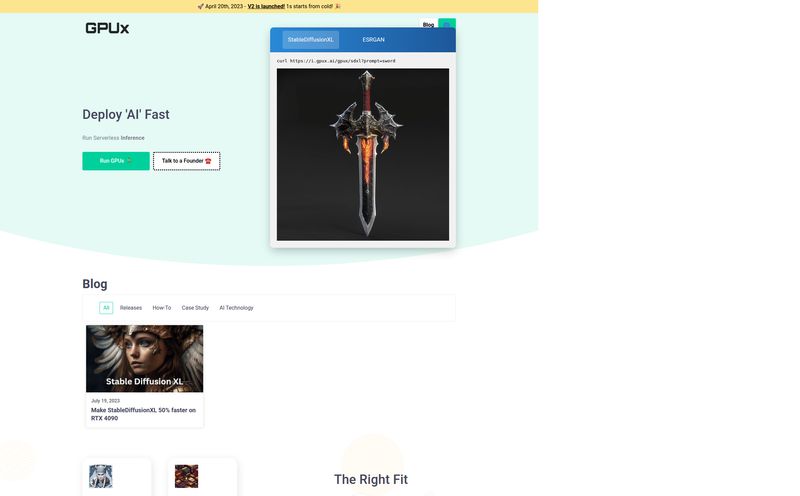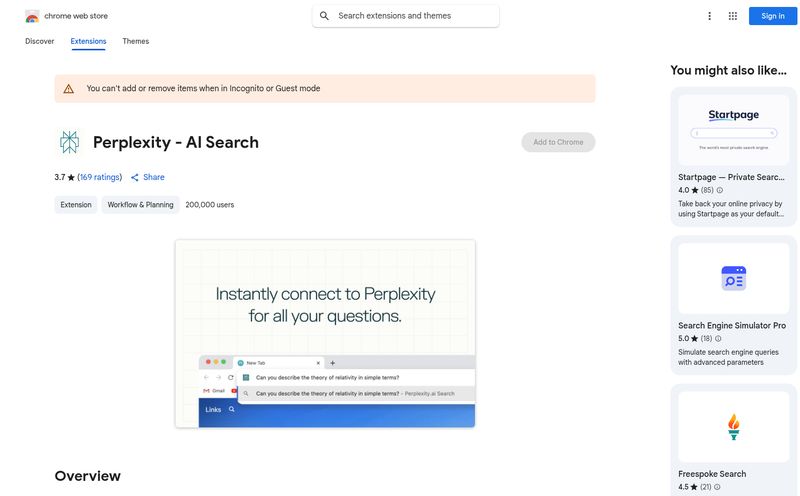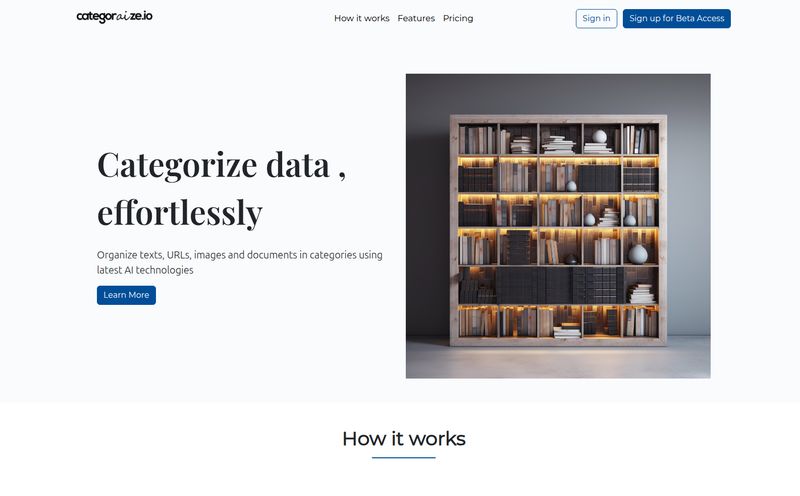For the past couple of years, my feeds have been an absolute firehose of AI news. "New model drops!" "This AI will change everything!" And look, I love it. As an SEO and traffic guy, I'm all for new tech. But there’s always been this nagging gap between the cool headline and actually doing something with it. It often feels like you need a PhD in machine learning and a team of developers just to build a simple, useful AI-powered tool.
You have an idea—a brilliant one, probably—for an internal tool or a little app that could save you hours. But the path from that idea to a working product? It's a canyon. A deep, code-filled, soul-crushing canyon. I've been there.
So when I stumbled upon a platform called UnifiedStacks, my professional skepticism immediately kicked in. Their headline, "Build AI Applications at the speed of thought," is bold. Very bold. They promise a no-code, drag-and-drop builder for creating production-ready AI solutions. My first thought? "Yeah, right." But my second thought, the one that always gets me into trouble, was, "...but what if?"
So, What Exactly is UnifiedStacks?
Think of it like this: UnifiedStacks is a Lego set for the AI world. You aren't grinding plastic to invent a new kind of brick (that's what OpenAI, Google, and Meta are for). Instead, you get a massive box with every type of brick imaginable—AI models, data connectors, user inputs, logic flows—and a big, friendly baseplate to build on. You get to be the architect, the creator, snapping pieces together to build your masterpiece without ever touching a furnace.
It's a self-service AI platform designed to put the power of application building back into the hands of the people with the ideas. The marketers, the business analysts, the operations managers, the entrepreneurs. People like you and me. The goal is to close that canyon between a great idea and a deployed application.
First Impressions: The Drag-and-Drop Experience
Okay, logging in, the first thing I noticed was the interface. It's clean, dark-themed (a big plus for my tired eyes), and it doesn't immediately overwhelm you with a million buttons. It gets straight to the point with a canvas that basically says, "Build your application flow here."
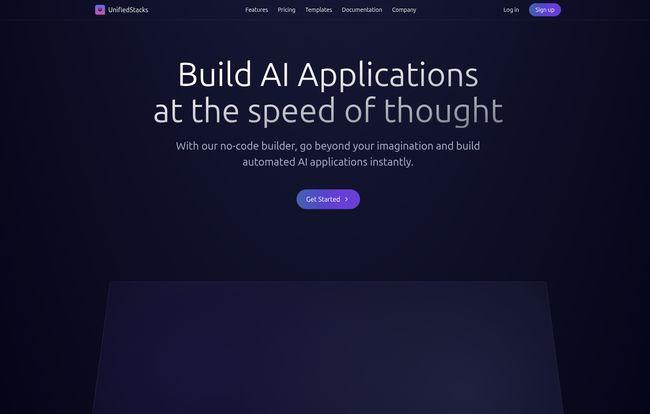
Visit UnifiedStacks
The core of the experience is this drag-and-drop builder. On the right, you have your toolbox, neatly organized into a few key categories:
- Layout & Input Elements: The basics for how your app will look and what information a user will provide. Think text boxes, file uploads, etc.
- Knowledge Base: This is where it gets interesting. You can feed the application your own data—documents, websites, images, videos. This is how you make the AI yours.
- Agents & Actions: This is the brain. You can pull in different AI models or actions to process the infromation and produce a result. For example, 'Summarize Text' or 'Extract Information from Document'.
It feels less like coding and more like drawing a flowchart. You literally drag a component onto the canvas, connect it to another one, and you’re building a logical sequence. If user uploads this document, then this AI model should read it and then generate a summary. It's incredibly intuitive.
The Powerhouse Under the Hood
An intuitive interface is nice, but it's useless if the tool itself is weak. This is where UnifiedStacks surprised me. It’s not just a simple wrapper around one API. It's a switchboard connected to the entire AI ecosystem.
Access to the AI All-Stars
One of my biggest pet peeves with some AI tools is vendor lock-in. You're stuck with whatever model they decide to offer. UnifiedStacks, on the other hand, is model-agnostic. The images on their site show integrations with a whole roster of heavy hitters:
- OpenAI (think GPT-4)
- Google Cloud (Gemini)
- Azure
- Anthropic (Claude)
- Mistral
- Meta (Llama)
This is huge. It means you can pick the best tool for the job. Need incredible reasoning? Maybe you go with a top-tier GPT model. Need speed and efficiency for a simple task? A smaller model might be better. You have the freedom to choose and even switch on the fly.
Connecting Your Data Universe
Here's the other part that makes this a serious business tool and not just a toy. An AI is only as good as the data it can access. UnifiedStacks claims to integrate with over 200+ data sources. That means you can pull in data from your existing tools and workflows. We're talking about connecting to things like:
- Google Drive and Sheets
- Notion
- Microsoft Word and Excel
- SQL databases
- Even services like Twilio and Wikipedia
"An AI without access to your specific, proprietary data is just a clever parrot. When you connect it to your knowledge base, it becomes a true team member."
This is the difference-maker. You can build an app that doesn't just know about the world, it knows about your business. That's when the magic happens.
Let's Talk Use Cases: What Can You Actually Build?
This is all great in theory, but what does it mean in practice? I started brainstorming based on the templates I saw, and the possibilities got me genuinely excited.
For example, that "YouTube Link to Blog" template. As a content creator, that's a workflow I deal with constantly. The idea of just dropping a video link and having the platform automatically transcribe it, analyze it, and draft a blog post is... well, it’s amazing. It’s a direct solution to a real-world time sink.
Or what about a "Chat with Internal Documents" app? You could upload all your company's HR policies, training manuals, and project histories. Then, instead of a new employee bugging their manager with questions for a week, they can just ask the app: "What's our policy on vacation days?" or "Show me the project plan for the Q3 campaign." That's not just cool; that's a direct improvement to operational efficiency.
You could create a lightweight sales analysis tool that takes a pitch deck, analyzes its strengths and weaknesses, and suggests improvements. The possibilities really are as open as that drag-and-drop canvas.
The Good, The Bad, and The Price Tag
No review is complete without a frank discussion of the pros, cons, and costs. So let's get into it.
What I Love About UnifiedStacks
The biggest pro is right in the name: no-code. This isn't just a feature; it's a philosophy. It democratizes technology and empowers creative people who aren't necessarily engineers. The speed is another major win. The promise of "one-click deploy" means your idea doesn't have to languish in development hell for months. You can build and launch an internal tool in an afternoon. And finally, the flexibility of integrating with so many AI models and data sources means the platform can grow with you.
Some Things to Keep in Mind
Now, for the reality check. The biggest question mark for larger teams is the pricing model. The top-tier plan is "Custom," which is standard for B2B SaaS but means you have to get on a call with sales to get a quote. This can be a bit of a hurdle if you're just trying to budget and compare options quickly.
The other point is the free "Hobby" plan. Don't get me wrong, I love that it exists! But with a limit of 200 queries per month, you'll burn through that very quickly if you build something even remotely popular. Think of it as what it is: a fantastic, full-featured trial to test the platform's power, but not a long-term solution for a live application.
So, How Much Does It Cost?
The pricing structure is straightforward, which I appreciate.
| Plan | Price | Key Features |
|---|---|---|
| Hobby | $0 | Get started for free. Includes 1 Project, 1 Application, and 200 queries per month. |
| Custom | Custom | Customized for your needs. Includes Unlimited Projects, Unlimited Applications, and a custom number of queries per month. |
Who Is UnifiedStacks Really For?
After playing around with it, I have a pretty clear picture of the ideal user. This platform is a godsend for the scrappy startup founder who needs to build an MVP fast to test an idea. It's perfect for the marketing manager who wants to build a custom analytics tool but doesn't have the dev resources. It's for the consultant who wants to create bespoke AI solutions for different clients without reinventing the wheel every single time.
Who isn't it for? Probably the hardcore Machine Learning engineer who wants to build and fine-tune neural networks from the ground up. This is an application layer tool, not a foundational research tool. And that's its strength. It knows exactly what it is and who it serves.
Conclusion: A Lego Set for the AI Revolution
Coming back to my Lego metaphor, UnifiedStacks feels like one of the most complete and exciting sets I've seen. It gives you all the specialized blocks—the powerful engines, the clear canopies, the data connectors—and a simple set of instructions to get you started. What you build from there is entirely up to your own creativity.
For years, the power of AI has been locked behind the wall of complex code. Tools like this are finally handing us the keys. If you’ve had an AI-powered idea simmering on the back burner, I honestly think you should give their free Hobby plan a spin. What have you got to lose? You might just close that canyon and build something amazing.
Frequently Asked Questions (FAQ)
What is UnifiedStacks?
UnifiedStacks is a no-code platform that allows users to build, deploy, and manage AI-powered applications using a drag-and-drop interface. It integrates with various AI models and data sources.
Do I need to know how to code to use UnifiedStacks?
Nope! That's the main appeal. It's designed for users without a coding background. If you can build a flowchart, you can build an application on UnifiedStacks.
What kind of AI models can I use?
You can access a wide range of state-of-the-art models from providers like OpenAI, Google, Anthropic, Meta, and Mistral, giving you flexibility in choosing the right AI for your task.
How many data sources can I connect to?
UnifiedStacks supports integrations with over 200 sources, including business applications, databases, and data warehouses like Google Drive, Notion, and SQL databases.
Is UnifiedStacks free to use?
Yes, there is a free "Hobby" plan that includes 1 project, 1 application, and 200 queries per month. This is ideal for testing the platform and building small personal projects.
Can I use UnifiedStacks for my business?
Absolutely. The "Custom" plan is designed for business and enterprise use, offering unlimited projects and applications with pricing and query limits tailored to your company's specific needs.
